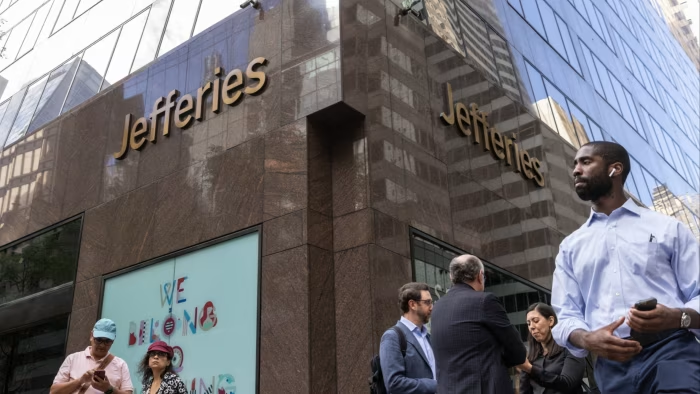Unlock the Editor’s Digest for free
Roula Khalaf, Editor of the FT, selects her favourite stories in this weekly newsletter.
Jefferies earned undisclosed fees on financing it provided to First Brands Group, in an arrangement other lenders say may have violated terms of their own credit agreement with the bankrupt car parts company.
The existence of the previously unreported “side letter” between Jefferies and First Brands threatens to become a flashpoint for other lenders as they try to get to grips with the bankrupt company’s labyrinthine balance sheet.
The collapse of the US car parts maker — which raised billions of dollars in poorly disclosed off-balance sheet debt — was accelerated by US President Donald Trump’s trade war, with tariffs heaping added financial pressure on the company as its underlying business was deteriorating. First Brands’ downfall has prompted recriminations from lenders and an investigation into its finances as part of its bankruptcy.
The US investment bank is under scrutiny for its long-standing relationship with First Brands, having placed billions of dollars of debt with fund managers who believe they did not have a complete picture of the group’s financial condition.
The most recent of these deals — an attempt to refinance $6bn of First Brands’ debt stack — ran aground in August as questions grew around First Brand’s financial disclosure. Filings have since shown the Ohio-based maker of spark plugs and brake components had missed interest payments on more than $1bn of off-balance sheet debt months earlier.
Separate from its banking relationship, an investment unit of Jefferies also provided more opaque financing to First Brands linked to its customer invoices. This lending was not widely known on Wall Street until a Financial Times report last month.
First Brands’ borrowing facility with Jefferies was provided through the bank’s Leucadia Asset Management division, by a fund known as Point Bonita Capital. First Brands would sell its customer invoices to Point Bonita at a discount, which allowed it to raise cash before customers such as car parts retailer AutoZone or Walmart paid for the parts they had received.
Alongside Point Bonita’s lending facility, the Jefferies unit also executed a so-called supplemental fee letter with First Brands.
The car parts company was restricted by terms in its agreement with other lenders from borrowing at high interest rates when it tapped invoice “factoring” facilities, a form of off-balance sheet financing.
The interest rate on those borrowings was capped at 5 percentage points over a floating interest rate benchmark.
The side letter allowed First Brands to sell its invoices at interest rates above that level. Interest on those invoices remained capped at the 5 percentage point spread but First Brands would pay several percentage points more in fees, depending on the invoices it was selling.
First Brands received a so-called non-contravention opinion from lawyers at the time the fee letter was agreed, a legal opinion to reassure the company that the arrangement did not violate terms in its loan agreement, a person briefed on the matter said.
Jefferies and First Brands declined to comment.
Side letters are often used in finance to offer certain lenders additional terms and sweeteners that are not disclosed in their main financing agreement.
Creditors have been perplexed by the Point Bonita fee letter when told by the FT of its existence.
Lenders have pointed to a covenant that dictates the interest on this sort of financing “shall not exceed” 5 per cent over a floating-rate benchmark, according to people who have seen the terms.
The covenant only dictated costs around interest and did not specifically mention fees. That could provide First Brands the legal cover to pay those higher costs without breaching its loan agreement, one lender added.
These covenants are considered to be critical defence measures for lenders, a warning sign that a company’s financial health is deteriorating or that its debt load is swelling. A covenant breach is meant to force borrowers and their lenders back to the negotiating table to find a solution, or provide creditors with remedies. For First Brands, a breach would have also prevented it from tapping term-loan lenders for additional money.
Several of First Brands’ lenders told the FT they had never seen the side letter in question. Others said they believe the additional fees either violate the covenants that safeguard lenders, or “is not in the spirit” of how the covenant was structured.
Jefferies could face substantial pressure on its Point Bonita fund because of its exposure to First Brands.
Point Bonita — named after a lighthouse overlooking San Francisco Bay — pitched itself as safe and secure to investors, according to marketing materials reviewed by the FT.
“Like its namesake, Point Bonita Capital seeks to serve as a steady beacon in a dynamic environment,” said one investor pitchbook.
But the fund is now listed as an unsecured creditor in First Brands’ bankruptcy.
Ross Berger, president of Point Bonita Capital, was a key engineer of the facility and the unit had more than $500mn of exposure to First Brands’ invoices, the people said.
The fund’s pitch documents state: “Berger and his team have many decades of combined experience managing complex portfolios across all economic cycles and market disruptions”.
Berger declined to comment through a spokesperson for Jefferies.

